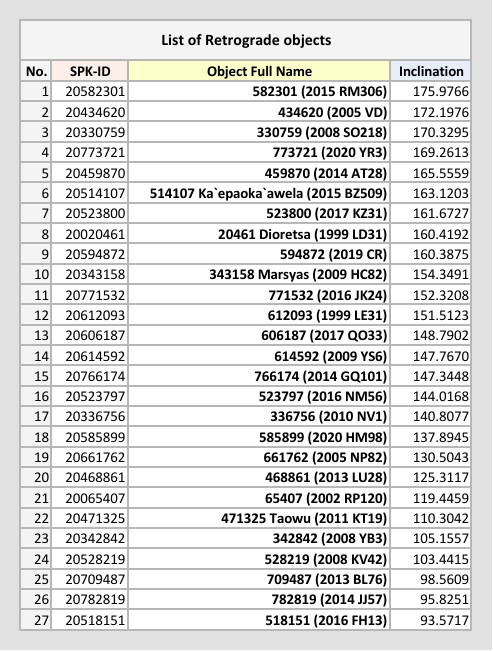The current comprehensive listing of IAU-named asteroids has been updated here with the release of WGSBN Bulletin Vol. 5, No. 21 (2025-09-22). There are 55 new namings in this bulletin. There are ten of particular interest to me lately: The first from this bulletin - 679829 Sucellos (2021 EC5), an Amor asteroid with a 3.36 yr. cycle, the Celtic and Gallo-Roman god of agriculture, fertility and the Underworld. Four from the previous bulletin (Vol. 5, No. 21) - the first is 55637 Uni (2002 UX25), a TNO with a 282.01 yr. cycle, the Etruscan goddess of love and fertility. The second is 78799 Xewioso (2002 XW93), a TNO with a 231.33 yr. cycle, a thunder god in the mythologies of the Ewe and Fon people of Western Africa. The third is 90568 Goibniu (2004 GV9), a TNO with a 269.98 yr. cycle, the god of metallurgy and hospitality in Irish mythology. And the fourth is 145451 Rumina (2005 RM43), a TNO with an 888.36 yr. cycle, a minor Roman goddess who was invoked as a protector of nursing mothers. The sixth (Vol. 5, No. 19) is 532037 Chiminigagua (2013 FY27), a TNO with a 450.63 yr. cycle, Creator of light and the world of the Muisca people of Columbia. Before Chiminigagua, there was only darkness. The seventh (Vol. 5, No. 19) is 696315 Petraios (2016 GR206), a centaur with a 90.45 yr. cycle, who fought in a battle between primal chaos and social order, “marking the edge,” as Ovid tells, “between structure and upheaval.” The eighth (Vol. 5, No. 17) is 145452 Ritona (2005 RN43), a TNO with a 268.46 yr. cycle, named after the Celtic goddess of rivers and crossings. The ninth (Vol. 5, No. 15) is 55565 Aya (2002 AW197), a TNO with a 324.49 yr. cycle, named after the goddess of the dawn in Akkadian mythology. Aya was the consort of the Sun god, Shamash. And the tenth (Vol. 5, No. 15) is 208996 Achlys (2003 AZ84), a TNO with a 249.06 yr. cycle, a personification of sorrow and grief described in the Greek epic poem, the Shield of Heracles. It is also used by Homer in the Iliad to describe the mist that covers the eyes of the dying.
We have four sorts - MPC No., Alpha-numeric, Period (yrs.) and Inclination. There are now four named objects with an inclination > 90°, which means they have a retrograde (Rx) orbit around the Sun. 20461 Dioretsa was the first Rx asteroid/centaur (discovered in 1999), with the befitting name of asteroid spelled backwards. Astronomers generally regard these objects as unnatural or unoriginal to the rest of the Solar System, perhaps having been captured long ago in a close encounter with our as-yet-undiscovered companion star system “Nemesis” or from the Oort Cloud.
As of the current tally, there are 847,427 MPC-numbered objects (excluding comets), 27 of them that are Rx, of which four are named (shown below). How many might receive names, we have no idea. We can track any of these, though, for astrologers interested who want an ephemeris.




This is awesome, and very helpful to the advancement of Authentic Astrology !